The State of My Garden So Far (Challenges, Mistakes, Pests and All)
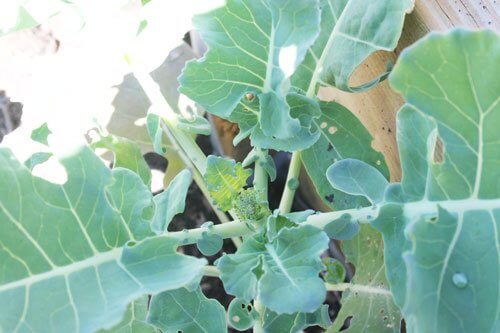
Challenges or not, I couldn’t give up gardening if I tried. Watching my plants grow, from a tiny seed into delicious food is just so rewarding (like this brand new broccoli head above, which we’ll be eating in a another week or two).
This marks our first full summer in our current home, and so far, the garden hasn’t been all I had hoped that it would be. We built garden boxes in the early spring (well, my brother-in-law built them) and then filled them with a truck load of dirt from a local nursery. The boxes are fantastic, nice and deep, with the option to remove the top layers and create extra boxes one day if I want to.
The first issue has been with the soil. I naively (having never purchased soil before, but always just working to amend what was in the ground) assumed that the soil would have a decent amount of nutrients and fertility already, and need only the regular fertilizing that I usually do throughout the summer. From the stunted growth, insect issues and sometimes obvious nutrient deficiencies, I was definitely wrong.
Now, I am playing catch-up with soil that is already thoroughly planted up, as I try to work in organic fertilizers, and add compost or manure when I’m able. It’s not ideal. It takes time for the microbes in the soil to properly break down fertilizers and make the nutrients available to plants. This fall, I will have to really build up the soil in preparation for a better season next year.
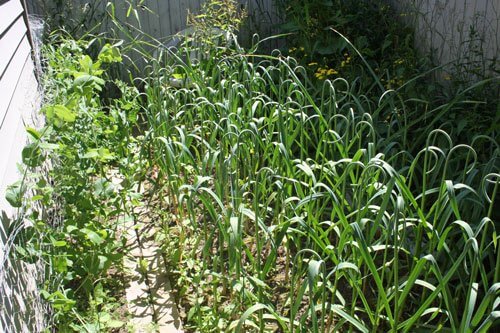
Some things are growing nonetheless. The peas on the left (after a very slow start, they’ve finally taken off and are producing well), the garlic I planted in the fall looks amazing and is about ready to be harvested, and the weeds, well, they’re abundant. Part of the garden back here doesn’t get enough sun to grow anything except weeds.
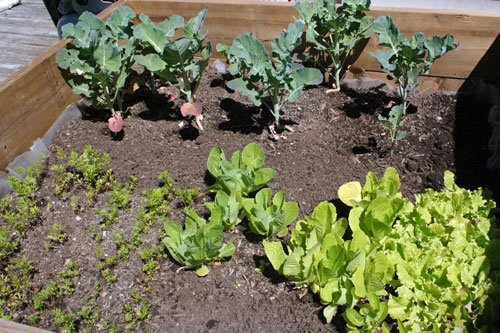
I mistakenly judged the amount of sunshine that my five boxes would receive. This box and the one next to it probably receive more sunshine than any other, although I initially thought they would receive less, and so I used them for my cooler-weather vegetables (lettuce, spinach, broccoli, cauliflower, cabbage, carrots, beets, kale). Next year I’ll know better.
I’m trying to really maximize my space. That empty row between the broccoli, and then the carrots and lettuce, now has beet seeds in it, as does that empty square up at the front.
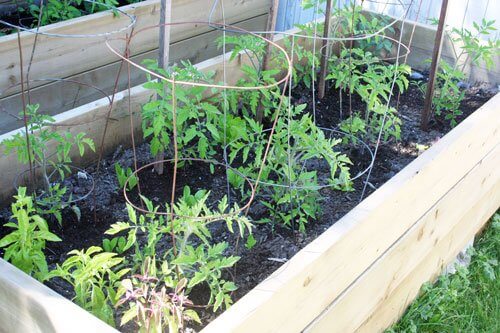
It may be difficult to see in this picture of mostly tomatoes, but in between the large plants, I’ve planted lettuce seeds here and there. The goal was to use up every bit of precious space available, as well as to capture the shade that the tomatoes would provide for the lettuce later in the summer. There’s also some basil tucked in on the end.
I am proud to say that I did have one huge victory this summer so far. Right before I left for the Philippines, my tomato seedlings were in the ground, but beginning to show definite signs of either disease or serious nutrient deficiency. I was unsure of what to do, but since I was about to leave, I just gave it my best shot, thinking I could always break down and buy new seedlings if mine were dead upon my return.
I ruthlessly cut away every branch and leaf that didn’t look healthy (so hard to do). Then I dug fertilizer and compost in around each plant, in a circle around the base (but not touching the plant). I watered the fertilizer in well, packed up for my trip, and hoped for the best. Well, my efforts were successful! When I came home, everything was bright green again, looking healthy, and starting to grow new branches in place of what I had cut off. Yes!
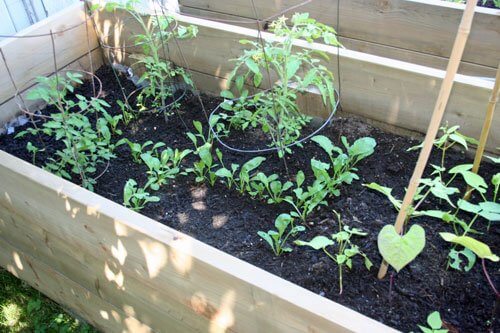
These two long boxes are beside each other, and they’re both having some of the same issues (not to mention that they are shadier than I expected when I planned to put tomatoes, cucumbers and beans in this space). Definitely slow growth like the rest of the garden, but also another mysterious issue that has me perplexed.
It seems that there is some sort of cucumber-loving insect in these boxes, and pretty much every time a new seedling pops its pretty green head up, it is eaten within a day or two. Some of them are even eaten below ground as soon as they sprout. Other plants are being nibbled on, like the radishes (again, planted in rows between tomatoes) and the beans, but nothing as badly as the cucumbers. Does anyone have a clue what’s going on with my poor cukes?

My fifth box, another sunny one. This has 4 red mini-bell peppers (I’ve opted for mini peppers because of their significantly shorter growing season, which suits our climate better than most peppers), two summer squash (one zucchini and one scallop squash), as well as 6 cucumbers (which I will grow vertically up poles) and then some (still small) dill and cilantro plants.
And yes, I do intend to weed out the weaker 4 of the 8 cucumber seedlings in the middle. With my cucumber issues so far this summer, I wasn’t taking any chances!
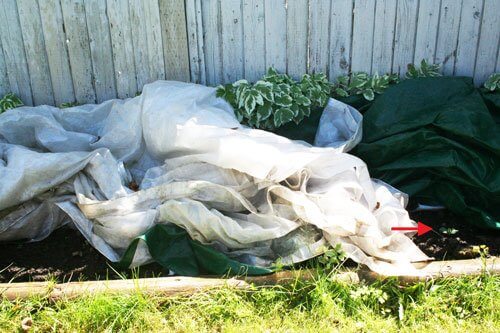
Lastly, the side garden, which was planted with something decorative and leafy long before we moved here. Last summer I tried to just dig up as much of the (very deeply rooted and invasive) plants so that I could put in some tomatoes. They did grow, but it was pretty mediocre. I think they had so much root/nutrient competition that they couldn’t flourish.
This summer I have been attempting to smother and kill off the original plants with these big sheets of plastic. Towards the front left and right you can see two openings, where I have put seeds, for Sugar Baby watermelons, and Butternut squash. The red arrow is pointing to the Butternut seedling that finally came up (second or maybe third attempt?), but the watermelon seeds still refuse to sprout.
I am contemplating putting in some blueberry or strawberry plants for next year instead, after leaving the garden entirely covered by plastic until the weeds (ahem, pretty plants) are gone. Any other ideas for me?

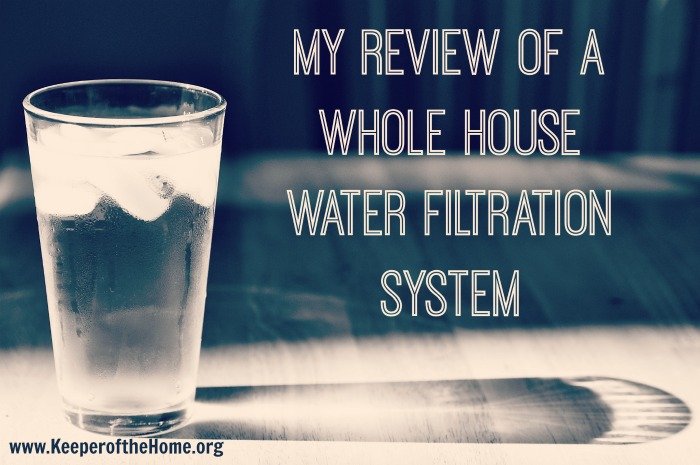

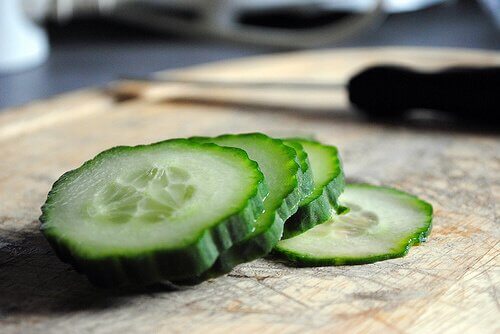

I enjoy your blog. Thank you for sharing your adventures. We started a garden three years ago with very similar circumstances; however, we live in NH. We brought in VERY poor soil to build some raised beds. I wanted to share a book with you that I read that I am sooooo glad I did! It is called “The Ruth Stout No-Work Garden book” It is old and may have to be inter-library loaned, but I would highly recommend it. It is the most simple and wonderful method of easy gardening using a hay mulch! This year I finally have worms and I see a beatiful rich layer of soil developing under the mulch hay! Read the book and see what you think. It is so easy that even I can do it! 🙂
Thanks again and have a wonderful and bountiful summer! 🙂
Kindest regards,
Debbie
Campton, NH
@Debbie, Thanks for the recommendation, Debbie, I will look into it! I’m glad I’m not alone with my soil issues.
Thank you, Stephanie, for the honest and realistic garden update!
We have had the same problems with soil. It was also our first year to attempt a vegetable garden and we have learned a LOT. Our yellow squash really took off and we got some great radishes, but our tomatoes have floundered. Our peppers didn’t take off either. We are in the midst of drought and record-breaking heat, so we have had to work hard against that, too.
Anyway, I guess we’ll chalk this up as our trial run year and take the lessons and the squash and try to do better next year!
@Megan at SortaCrunchy, Oh, sorry to hear you’ve had the same problems. Glad that some things worked at least. It’s been the same for me- a few things are great, and then others just not so much. But that’s ok. Next year will be better for us both!
I’m glad I’m not the only one whose cabbage plant looks like that. The little worms got the best of me this year. 🙂
As for planting blueberries next year, just an FYI – they need pretty sandy soil to grow and lots of room. Blueberry bushes can get very large. I’ve never tried to grow them, but I’m pretty sure they need just the right conditions to produce anything. But strawberries could definitely be done in boxes. Good luck!
I put ground egg shells (from my pastured eggs) in the holes when planting, and toss some kombucha and extra SCOBYs into the garden every couple of weeks. I water it regularly. Now, I’ve had this patch for 4 years and have added lots of egg shells and other compost to it over that time. But the garden is amazing this year, I’ve never had plants grow so big, so green, or flower so early. I have almost two dozen tomatoes out there and it’s the first week of July! (Not to mention cucumbers, zucchini, peppers, potatoes…)
@Kate @ Modern Alternative Mama, Sigh… sounds like my old garden that I had worked so hard on. I just need to keep puttering away with this new one and I’m sure it will get better each year!
This is my first real attempt at a garden (raised bed). I thought I was doing pretty well until I drove through the country and saw what other gardens look like by now. Mine looks pretty puny. I spoke with local gardeners about what soil mixture to use and thought I would be doing great. I think I need a good bit more fertilizer. I need to find a better way to spread my fish emulsion.
Thankfully, I’ve also joined a CSA and start pick up on Monday. I had high hopes for my garden, but was also trying to be realistic. Next year will be even better!!
The garden pest eating your cucs is likely earwigs. You can put down diatomaceous dirt to kill them off otherwise they get very prolific ! Diatom dirt is just ground fossil bugs so not harmful to the garden.
The use of space is great,we use toms to shade the lettuce too, one idea for the shadows spots is to set up something reflective to direct extra light toward th bean plants. White painted wood on an angle would work. FYI on blueberry bushes is you need 3 bushes, 2 female and a male near eachother,so plan accordingly.ever bearing raspberries would be my choice for the spot, they would fill in nicely and kill off competition easily.
Best of luck and just keep working at it.
@Jamie, Earwigs, huh? You could be right. I hadn’t thought of that. I definitely do NOT want them to be prolific (not only for the sake of my garden, but because they are the one bug that truly gives me the heebie-jeebies!)
@Stephanie @ Keeper of the Home, I was going to suggest the same thing. I’ve recently had my beans, squash, AND cuke seedlings just munched into oblivion. I’ve tried DE in the past with mixed results, but this year I bought some Neem oil for one last-ditch effort against squash bugs (which haven’t come… so far) before inviting Monsanto to build a chemical plant on my property. 🙂 In any case, the past 2 nights I’ve gone out after dark with some neem oil in my sprayer (I added dishsoap too, though the neem says you don’t need to) and Hubby’s headlamp on my forehead. Earwigs BUSTED! The soap/oil did a good job on them (even though I couldn’t find reference to them in any of the Neem info). You can also roll or crumple up newspaper, they’ll crawl in (after spending all night eating, probably) and then gather them up to burn, or dump them in the middle of hot asphalt or something. 🙂 Good luck!
@EllaJac, I’ve heard of Neem and that it works well. The only negative thing I’ve heard is that it can kill your beneficial insects as well. But, when you can’t even grow a seedling because of the silly things, perhaps it’s worth it…
Your comment was hilarious to read. You obviously has the same disdain that I do for earwigs. I’m sure the good Lord has a reason why he made them, but I can’t for the life of me figure out what it is. 🙂
@EllaJac, I’m trying to reply to Stephanie but I can’t seem to reply to her reply. Anyhow, from what I understand Neem oil is only harmful to beneficial insects if you spray it directly on them. Any only on a bug can suffocate them. However, if you put it on early morning or late evening then the good bugs are gone to sleep and you can either spray the bad bugs or just spray the plant and it will absorb in.. the good bugs don’t actually eat the plant so its not harmful to them after it dries.
@Sonia, Don’t worry, I got the reply, Sonia! 🙂 Thanks, that’s helpful for me.
@Jamie, I have extremely prolific earwigs and for some reason the diatomoceous earth stuff didn’t work at all for me. I think that it didn’t stay dry long enough to work (with all the rain that year). Like I said below the dish soap was the best method for me. But I agree I think its earwigs!
Living near the coast in the Pacific Northwest, is always a challenge for gardening, especially on cool rainy years like this. I have a beautiful garden plot that my husband prepared for me 15 years ago. He hired a dirt guy to come in with a backhoe and scoop out the rocks and the little bit of soil and put it through a royer (sp?) to separate the two, putting the soil back in the garden area. He brought 2 truck loads of peat from a local peat bog, sand and manure. This was tilled so it was about 3+ feet deep of garden soil. It is lovely. Every couple of years I viist a local organic dairy and get a couple of pick up loads of manure and till it in. Over the years of gardening I have discovered the things that just don’t do well in our cool climate and the ones that do great. I like to attend workshops by our local Master Gardeners to glean more tricks. My cool season crops always do nicely–peas, broccoli, cabbage, cauliflower, spinach, lettuce, rhubarb and beets. Those are the staples in my garden. This year I tried a little trick for my pole beans as the soil temperature must reach between 65-70 for germination which in our area may mean mid-July–too late for any harvest. So this year I germinated them indoors just until they were 2-3 inches tall, then planted them in the garden and they are now starting to head up the bean pole–so maybe some green beans this year. Tomatoes are a hit and miss proposition, but selecting the right variety for your climate is very important–I always have luck with Stupice. Start planting those fruits and in a couple of years you will enjoy fresh strawberries, blueberries and raspberries. Hang in there, it takes time to build your soil, get to know your sun and space, but before you kjnow it you will be enjoying a plentiful harvest!
@gogardengirl, Thanks for the reminder to be patient. I need it. I spent the 3 previous years building up the garden at my last house, and by the time I left it was a wonderful, fertile garden where I had a lot of success. It’s always hard to start over, but I’m sure that next year will be better. 🙂
I love seeing your garden progress. It would be fun to grow some berries in that area where you are smothering the pretty plants 🙂
Mine garden is growing very, very slowly this year. I’m trying to figure out how to deal with our soil. It is mostly sand. Plus I am SO bad a watering!
For improved soil, you might want to think about “lasagna gardening”. There is a book by this title and it explains the whole concept, but you can also search that term and it should yield some good websites. Essentially, your raised bed garden soil is built in layers, like a lasagna, using materials that you would use in a compost pile such as straw, produce scraps, yard waste (no weeds), grass clippings, etc. Add amendments like some organic soil, manure, etc. and in the spring you should have good, rich, organic soil to plant in. My biggest battle this year has been cabbage white caterpillars on my broccoli plants. I sprinkled some cayenne pepper on the plants after plucking the little fellas off and they haven’t come back. 🙂
@Valerie, I did some caterpillar plucking by hand, which seemed to help, but also did as you did, using cayenne pepper, combined in a spray with raw garlic. It seemed to help them from coming back. I’ve only found one since.
@Stephanie @ Keeper of the Home, Do you end up with garlic- or pepper-flavored cabbage, if you do this? I’ve given up cole crops because of those buggers…
@EllaJac, I don’t know. It’s my first year trying the spray. But I have found that once I started picking off the caterpillars by hand and then just sprayed a couple of times, the munching has decreased so greatly that I haven’t been spraying anymore. Maybe it’s most important just when they’re small and vulnerable?
Thanks for the realistic update. It is encouraging for any new growers to know there is lots of ‘adversity’ in the soil to face but with trial and effort, each year a garden can be better. That horrible “weed” in your last picture (I forget the name) is just that. You could even keep black plastic on the area next growing season and plant your berries or vegetables right in the plastic. That weed won’t be able to rear it’s ugly head then. We have great success growing in plastic as it keeps the weeds out and gives some plants the heat they really crave. We grow blueberries commercially and they like peaty, hummusy soil. They are a great fruit on the westcoast, native to this place and easy to grow. I think they’ll do wonderful in your garden as would strawberries. Plant the ever-bearing variety as we often don’t have nice enough June and early July to get a decent crop from June-bearers. I’m with you, I don’t pull extra plants until I know the others are vigourous. My theory is that pests are having a hay day this year because of the cool weather. Plants just can’t get a good start growing and so remain weak and stunted and susceptible to the bugs. But as you know, perfect soil also would deter them.
@Andrea, I appreciate the blueberry tips, thanks!
I am quite familiar with that pernicious weed. I have the variegated type where it isn’t bothersome (much less aggressive) and had the plain “original” type in my front flower beds. One summer I dug deep (at least 2 feet – down to China really) and SIFTED all the soil before replacing it. You likely know that the tiniest root will spring back to be a large plant before you get up the next morning. I replaced all my perennials and bulbs and amended the soil and so far it hasn’t returned. Also, in the cracks of my sidewalk, I use boiling water and/or epson salts and/or water softener salt (which I was experimenting to use in my washer, as I don’t actually have/trust a water softener) to kill weeds, including this one. These items don’t hurt the environment in my opinion, especially at the lazy rate I use them. Hope that weed solution isn’t too depressing, especially if you can’t control what is on the other side of that fence.
Cucumber bug — not the cucumber beetle? Nasty yellow and black striped (in NY) beetle, loves all squash family plants.
I’m sorry that you are having a rough summer of gardening but it is nice to hear I’m not the only one!
We just bought our first home so this is our first year with more than a pot or two of container tomatoes. We did the same thing with soil in our raised beds. The “top soil” we bought was pretty much just clay. Even after the addition of manure and compost, it was not the rich soil I was imagining.
Most of our plants are growing well but we aren’t getting any fruit of them and I’m not growing cucumber for its looks!
You also might have a cutworm devouring your cukes. They are famous for snapping off plants as seedlings. Try putting cut-in-half 2-liter soda bottles over them while they get their start.
After 10 years of pregnancies and nursing (5 little ones) I have finally planted our first garden:) Applying all of the lessons learned from “the square foot garden” and our garden, in souther GA, is amazing!! Praise God! All that to say I highly recommend this book.
It’s nice to see I’m not the only one with problems. I’ve only planted my garden twice. Each time I can at least say that I’ve learned what not to do so I figure in a few years I should actually be able to do it right. ;).
I planted beans on either side of my tomatoes, not thinking that the beans would grow fast and provide way too much shade for the tomatoes to grow.
That’s about the only thing that I really messed up on my own but I’ve also had squash borers that resulted in just 1 zucchini and harlequin bugs that made me pull up my 2 year old collard plant. Add to that the INTENSE wind we’ve had that made my beans grow up big and strong but not produce a single pod and whatever it is that ate my herbs as soon as they sprouted and we’ve not gotten much at all but sweat out of it yet. But there’s still the fall to come!! 😉
We started our garden last summer…with pretty good success! We had a few failures, some plants not growing, but all in all we yielded a lot of produce. We bought a cubic yard of compost from a local dirt yard cheap for like $20 (fills the back of a pick-up), put in a couple bags (cubic ft) of steer manure, and a bit of our own worm compost….worked great! (our squash riveled those we saw at the OC Fair, ha!). We get very little weeds…I think that it’s due to using “fully cooked” compost to start with (sorry, don’t know the technical term)
http://heartandhaven.com/2011/06/13/tips-for-organic-gardening-at-home/
This year our “home” garden we had to start a 2nd time. We had issues with our soaker hose not working and nothing grew. Hubby fixed the water, we re-planted, and now things are starting to grow again.
About your cucumbers- do they have earwigs out west? They are a HUGE pest here. You can only see them at night. They are so bad here they get into our basements and if you go down in the night you can find them scurrying for shelter…gross! I have found that spraying the egdes of my garden, or, if needed, the actual plant, with natural dish soap/water mix helps a lot. Also I do this around the edges of my basement windows when needed. They are worse some years (wetter years). I had issues with planting all my cucumbers last year where the earwigs would just eat them off as soon as they popped up just like you describe. I started covering them overnight with yogurt containers weighted down by rocks until they got bigger, and spraying around that with the soap. In the morning I took the container off. This allowed them to get big enough that the earwigs left them alone. They like new shoots. Sometimes they will eat the leaves later a bit but not enough to harm the plant as its bigger. This year I didn’t want to mess around with the yogurt containers so I just started my cucumbers in batches. I start A LOT (20 plus) since that way some live. I get about 10-15 that live. I started some when I started my tomatoes inside (mid April for me), which was an experiment, but I have baby cukes already out there! Yay! I did these in plastic pots though and they got some shock from this but recovered once I started shading them each day for about a week. Next year I would do those peat pots. I did this with some more seeds that I started some later since I didn’t have much room inside, and did them in peat pots. I think that was in the middle of May. Warm enough here most days to be outside but I brought them in during the nights (too cold plus the pest issue). I brought them in and out until they had a few leaves and then planted them, peat pot and all, and have had no pests eating them now. I planted them later about June 15th. So anyways…this is the different ways I have used to beat the earwigs that mow off my tiny cucumber seedlings.
Other than that my garden is doing well this year. I am trying some new varieties of kale and have found another good spot for it to grow. Last year’s was a flop mostly since it had too much shade. I have gardened here long enough (4 seasons now in this yard) to know what works well where and how to work that out with needing to rotate things. It takes time, so give yourself some slack! 🙂 And every year I still make some mistakes.
Do you know when broccoli is supposed to get a head on it? I don’t have any clue why mine look like all leaves. Big, healthy leaves, they were started mid April. No head showing that I can tell, but I can’t really see it in your picture either.
@Nola, All that cucumber and earwig info is super helpful, thanks hon!
Glad to hear your garden is doing well this year! That must feel nice, to have mostly figured out your yard/climate and know what works.
For me, broccoli seems to get a head sometime around early July, but only 2 of my 7 plants have a head so far. And it’s really small in that picture, so you can’t see it very well. That was taken 2 days ago, so the heads are slightly bigger now, although growing slower than they seemed to last year. Maybe I’m just not remembering correctly. I seem to have issues with actually writing things down in a journal so that I remember them. 🙂
@Stephanie @ Keeper of the Home, Okay sounds good, thanks. I will have to see if mine get a head. However I think the wost part of my garden this year is wanting it so badly and not being able to eat some of the produce since I can’t stomach it. 😛 So far, broccoli is a no go for me. My kids will enjoy it if it gets a head.
Oh I also wanted to add about the earwigs- I’ve tried all sorts of things. Trapping them in various methods didn’t work well for me. They are bad some years and not others. Wet years are the worst. The soap has been the best method for me. And can live in some neighbourhoods and not others in the same town, apparently! The best method I have had is putting out larger seedlings of the things they like, not planting certain things they really like, and realizing that sometimes they do damage and then the plant recovers (I’ve had bean, tomato and carrot plants stripped down and grew back) and earwigs LOVE marigolds so don’t try that. LOL
@Nola, It’s interesting to know that wet makes it worse. The two beds where I am having all the problems are the ones that get the least sun, and thus they stay the most damp. The sunnier bed where I have cucumbers coming up hasn’t had the same problems at all. It must be earwigs– that just makes so much sense. I’m getting out my soap tomorrow!
@Stephanie @ Keeper of the Home, I meant to add too that when you have raised beds that the earwigs like to hide in the little cracks and crannies in the wood. Like where the sides and ends join together. So spray the soapy water in there. Sometimes I’ve seen the earwigs then come out and try to get away. The best is when you can actually spray them with the soap…they die. I know its not nice…but anyways…if you find the place they are hiding that is the best. They like to hide anywhere damp and dark. You can go out at night and spray them with the soap you just find them with a flashlight.
yeah, i have had issues in my garden this year as well. we put raised beds down and are trying a square foot garden. my husband put chicken wire on bottom to keep out any pests, but we have blackberry bush shoots growing up as weeds in the garden beds! (we have blackberries i cut back in our backyard that apparently have quite the root system underground. not sure what to do about this problem next year. also, i didn’t realize my soil mix was low on nitrogen, so quite a few of my plants had a late start until i fertilized them and they began growing better. my potatoes are doing almost too well… they took off when everything else lagged behind, so they started shading things and that was not the plan. i won’t put them in the square foot beds next year but will probably make them their own bed. anyways, i guess i feel like i am learning more and more as i go and have to problem solve. there are small green tomatoes growing on the tomato plants and i am happy about that! basil is thriving and the squash is flowering though it has no fruit growing yet. soon i hope! thanks for being transparent about your failings and successes – it is encouraging to me that i am not the only one learning as i go.
@charis, Nope, you’re certainly not the only one learning as you go! Every year, I have different successes and challenges in my garden. Sometimes the different issues surprise me, but I always learn something and I still love it!
@charis, Funny, my potatoes are one of my best crops this year. They look amazing and it’s taking all of my restraint to not get in there and steal a whole bunch of baby potatoes. 🙂
I’ve been reading a book that you might LOVE. It’s called, “Minifarming: Self-Sufficiency on a 1/4 Acre of Land”, by Brett L. Markham. It’s amazing. I wanted to do some serious gardening, but we only live on an acre of land…including our house. This book has been invaluable! Another great resource is “The Vegetable Gardener’s Bible”, by Ed Smith. It would really help out with your pest issues. Also, I just was reading through your comments and noticed someone mentioned something about blueberries. They’re actually INCREDIBLY easy to grow, but there are a few things you need to do to make sure you have success. They need more than one bush and they work best when you have different types of plants. You also need to buy agricultural sulfur (it acidifies the soil). It’s the same stuff you use if you want to turn your hydrangeas blue, fyi. Also, you should plant them in the spring or fall and pinch the buds to give them a year to establish good, strong roots and produce nice leaves. Keep ’em acidic and give ’em room! Also, I had a rough start to my tomatoes too (second year now…not in a row though), you might consider pinching the blossoms on some of the smaller tomato plants that have started to blossom. They won’t have enough “greenery” to support the tomatoes. I learned that the hard way! I love looking at people’s gardens! Thanks for sharing! I took a ton of pictures starting in June on facebook. If you’re interested in seeing how a version of a minifarming garden looks, let me know and I’ll try and share the album.
@hilary, Thanks for the blueberry tips. I’m thinking I might get some in the early fall, and see how they do for next year!
The leafy plant in your garden bed that you’re trying to be rid of is Bishop’s Weed or Snow on the Mountain. It’s a total pain to get rid of but it can be done if you are diligent at digging down and getting all the runners out. The downside of the plastic you have layed down is that you can kill all the “good stuff” in the soil while trying to kill off the Bishop’s Weed. Best to just use elbow grease and dig, dig dig. =(
I think it’s great that you shared your garden struggles and triumphs. The nice thing about gardening is that next year, you can do it differently!!!!
I saw all the posts about earwigs. It could also be rabbits. We had trouble in the fall with something eating our little plants (of any kind) as soon as they appeared. Then we found a nice rabbit hole in our yard. We put up a metal rabbit fence, and we’ve had no more trouble. (Just make sure you actually use rabbit fencing–it’s thicker than regular wire fencing, to stand up to their strong teeth, and it has specially sized openings to keep them out.)
Thought you might be interested in this website about gardening, it is based on New Zealand weather and growing conditions but has a wealth of info. I am going to one of their courses on how to grow nutrient dense food in September.
It is a challange to get our soil growing plants well! I am working on that at my place too – though we have heavy clay soil, so in winter (now) any hole dug just fills up like a bath!
Here is the website:
http://www.koanga.org.nz/
Late to the party, cause we just got back from vacation (and Im more of a lurker anyway). I felt moved by God this year to plant my first garden. Really garden is a highly grand term to use as I only have pepper and broccoli plants. I was fortunant to be able to go to my local green house run by some of my church mates and purchase 12 red bell pepper plants for 3 dollars total. I got them planted in the only area I have for gardening at all (our yard is a misfortune sadly). However, the soil where the garden went has been resting so to speak for almost 3 years, and was lovely and dark. I faithfully watered the plants and praised the Lord for His guidance (in making my garden) and asked for His care of the plants. Then I went on vacation and forgot to ask my neighbor to water. I was absolutely certain that I would come home to find dead plants. But God indeed provided and we have had an extremely wet summer. The plants were almost 2 feet tall and already producing peppers. I should be able to harvest 3 peppers in the next 2 weeks, and another 30 or so in a month. Well see how many more come in after that, as there are flowers covering them.
Next year I will be better prepared and purchase planting beds to put on my porch to grow more vegetables, and planters for the front to grow herbs. I am setting aside money each month to be able to buy everything Ill need to grow not just peppers and broccoli (which are the two I started with because they are outrageously expensive where I am), but hopefully asparagus and lettuce as well as some berry plants.
My first ever attempt at a garden I planted cucumbers and cantaloupes and tomatoes and carrots and all kind of other stuff, but the only two plants that survived and killed my other plants were the melons and cukes. I decided I didn’t like cucumbers that much haha. Didn’t have a problem with any type of bugs eating the cucumbers then that I know of. A fellow I know told me that cucumbers can be invasive (which I found out!) and I should use an upside down planter for them, like the topsy turvy thing you see on TV (never tried it, dont know if it works). He suggested two liter bottles to hang. Ill have to figure out what he meant =)
Sorry for the long windedness on a semi older post, but if you’re going to do a first post, might as well do it right! =)
i know what is eating your cucumbers!! They are called Cut Worms! We used to have problems with them in our garden growing up in minnesota. The way my mom always took care of the problem was: if you take a plastic cup and cut of the bottom so its open at both ends, then you place that around your plant 2″ deep in the dirt leaving an inch or two out of the dirt as well. Funny thing about cut worms is they cant go any deeper than an inch or 2 in the dirt and they cannot come out side the dirt in the sun, so if you protect your plants this way the cut worms cant get them!